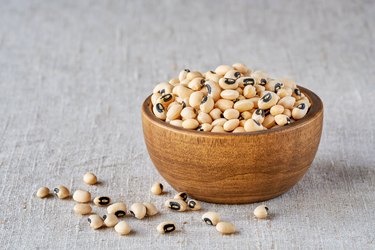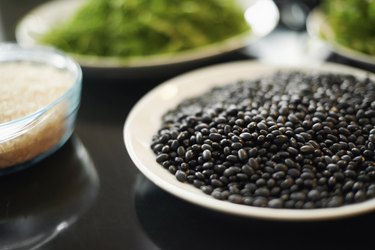
Black-eyed peas, also referred to as cowpeas, are a type of legume, which is a vegetable class that also includes beans and lentils. Black-eyed peas provide a low-fat source of protein, iron, potassium, folate, magnesium and fiber per the U.S. Department of Agriculture.
Canned black-eyed peas cook more quickly than the dried version of the legume, but usually have much more added sodium. Because canned black-eyed peas are precooked, options for eating include using them straight from the can in casseroles or salads, or heating them up to eat as a side dish.
Video of the Day
Video of the Day
Things You'll Need
Canned black-eyed peas
Colander
Saucepan
Instructions
- Decide how many cans of black-eyed peas you will need. One 15-ounce can contains approximately four servings.
- Inspect the can for any dents or bulges and watch for fluid squirting from the can when opening it. These indicate the possible presence of a bacterium called Clostridium botulinum. The bacteria can cause a serious infection called botulism, according to the Centers for Disease Control and Prevention.
- Throw away any cans with dents or bulges, or that squirt liquid when opened. Also, toss out the can of black-eyed peas if the food has a bad odor.
- Open the can of black-eyed peas and dump them in a colander.
- Rinse the beans with water. This will help remove excessive amounts of sodium used in the canning process.
- Pour the peas into a medium pot and fill with enough water to cover the peas.
- Place over medium heat and stir occasionally while the black-eyed peas heat up. Add any additional ingredients or seasonings you wish as they cook. Some possible samples include bacon, chopped onion, salt and pepper.
- Simmer for approximately 15 minutes, until heated through.
- Serve hot.
- Refrigerate any leftover black-eyed peas in a covered glass or plastic container and eat within four days.
Common Questions
Do black-eyed peas need to be drained?
It's a good idea to drain and rinse your black-eyed peas. Doing so will help remove some of the sodium used as a preservative in the can — more than 30% of it, according to the University of Illinois Extension. It is safe to eat these beans without draining or rinsing, but doing so could affect the flavor and texture of whatever recipe you're making, so keep that in mind.
Can you season black-eyed peas without meat?
You don't need any meat to cook up a delicious black-eyed pea recipe. Vegetarians, rejoice!
Making black-eyed peas vegetarian or vegan is often as easy as leaving out the meat of a recipe. If it calls for ham, just leave out the ham! Simple as that. You may want to add more vegetables and spices to amp up the flavor.
Check out the University of Arkansas's recipe for Fiesta Salad, a meat-free black-eyed peas recipe that calls for a colorful concoction of peas, corn, onions and peppers — and absolutely no meat.
Are canned black-eyed peas healthy?
There are plenty of health benefits of black-eyed peas. The canned version often contains a lot of sodium, so when possible, choose a can labeled "low-sodium" or "no-sodium." If you can't find those, rinse and drain the beans, which can reduce the salt by up to 36%, per North Dakota State University.
Black-eyed peas are a great source of folate: Each 1/2-cup serving of black-eyed peas offers up nearly 105 micrograms of folate (vitamin B9), equivalent to 26% of the recommended daily value (DV).
While most Americans get enough folate from their diet, a deficiency could lead to megaloblastic anemia, a condition that can lead to symptoms including fatigue, trouble concentrating, headaches and heart palpitations, according to the National Institutes of Health (NIH).
A 1/2 cup serving of canned black-eyed peas, according to the USDA, contains:
- Calories: 80
- Protein: 2.6 g
- Fat: 0.3 g
- Cholesterol: 0 mg
- Carbohydrates: 17 g
- Fiber: 4.1 g
- Sugar: 2.7 g
- Protein: 2.6 g
- Folate (B9): 26% DV
- Vitamin A: 22% DV
- Vitamin K: 18%
- Manganese: 21% DV
- Copper: 12% DV
- Magnesium: 10% DV
Are canned black-eyed peas already cooked?
Yes, canned black-eyed peas are already cooked. This means you can eat them straight from the can. Still. they'll be more delicious heated up and flavored to your liking. Dried beans, on the other hand, are not cooked, which is why they take longer to prepare.
- U.S. Department of Agriculture Nutrient Database: "Black-Eyed Peas, Low Sodium, Canned"
- MayoClinic.com: "Beans and Other Legumes: Types and Cooking Tips"
- Centers for Disease Control and Prevention: "Botulism"
- The University of Illinois Extension: "Enjoy Black-Eyed Peas All Year"
- University of Arkansas: "Black-Eyed Peas are a Traditional New Year's Dish"
- North Dakota State University: "All About Beans Nutrition, Health Benefits, Preparation and Use in Menus"
- NIH: "Folate"


